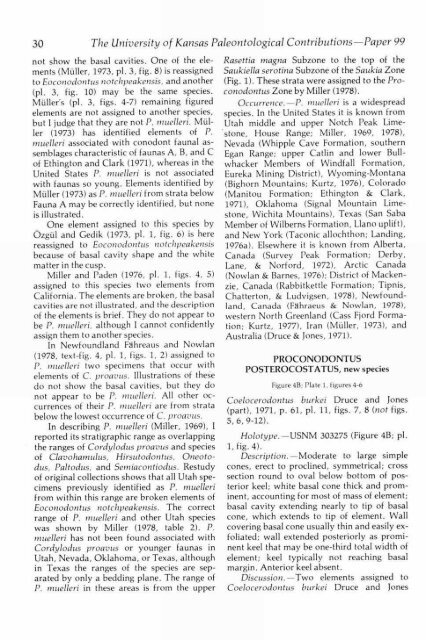View - KU ScholarWorks - University of Kansas
View - KU ScholarWorks - University of Kansas
View - KU ScholarWorks - University of Kansas
You also want an ePaper? Increase the reach of your titles
YUMPU automatically turns print PDFs into web optimized ePapers that Google loves.
30 The <strong>University</strong> <strong>of</strong> <strong>Kansas</strong> Paleontological Contributions Paper 99<br />
not show the basal cavities. One <strong>of</strong> the elements<br />
(Müller, 1973, pl. 3, fig. 8) is reassigned<br />
to Eocotiodotttus notchpeakensis, and another<br />
(pl. 3, fig. 10) may be the same species.<br />
Iler's (pl. 3, figs. 4-7) remaining figured<br />
elements are not assigned to another species,<br />
but I judge that they are not P. tnuelleri. Müller<br />
(1973) has identified elements <strong>of</strong> P.<br />
muelleri associated with conodont faunal assemblages<br />
characteristic <strong>of</strong> faunas A, B, and C<br />
<strong>of</strong> Ethington and Clark (1971), whereas in the<br />
United States P. muelleri is not associated<br />
with faunas so young. Elements identified by<br />
Müller (1973) as P. muelleri from strata below<br />
Fauna A may be correctly identified, but none<br />
is illustrated.<br />
One element assigned to this species by<br />
Ozgül and Gedik (1973, pl. 1, fig. 6) is here<br />
reassigned to Eoconodontus notchpeakensis<br />
because <strong>of</strong> basal cavity shape and the white<br />
matter in the cusp.<br />
Miller and Paden (1976, pl. 1, figs. 4, 5)<br />
assigned to this species two elements from<br />
California. The elements are broken, the basal<br />
cavities are not illustrated, and the description<br />
<strong>of</strong> the elements is brief. They do not appear to<br />
be P. mud/en, although I cannot confidently<br />
assign them to another species.<br />
In Newfoundland Hhreaus and Nowlan<br />
(1978, text-fig. 4, pl. 1, figs. 1, 2) assigned to<br />
P. muelleri two specimens that occur with<br />
elements <strong>of</strong> C. proavus. Illustrations <strong>of</strong> these<br />
do not show the basal cavities, but they do<br />
not appear to be P. mud/en. All other occurrences<br />
<strong>of</strong> their P. inuelleri are from strata<br />
below the lowest occurrence <strong>of</strong> C. proauus.<br />
In describing P. muelleri (Miller, 1969), I<br />
reported its stratigraphic range as overlapping<br />
the ranges <strong>of</strong> Cordylodus proavus and species<br />
<strong>of</strong> Clavohamulus, Hirsutodontus, Oneotodus,<br />
Paltodus, and Semiacontiodus. Restudy<br />
<strong>of</strong> original collections shows that all Utah specimens<br />
previously identified as P. muelleri<br />
from within this range are broken elements <strong>of</strong><br />
Eoconodontus notchpeakensis. The correct<br />
range <strong>of</strong> P. tnuelleri and other Utah species<br />
was shown by Miller (1978, table 2). P.<br />
muelleri has not been found associated with<br />
Cordylodus proavus or younger faunas in<br />
Utah, Nevada, Oklahoma, or Texas, although<br />
in Texas the ranges <strong>of</strong> the species are separated<br />
by only a bedding plane. The range <strong>of</strong><br />
P. muelleri in these areas is from the upper<br />
Rasettia magna Subzone to the top <strong>of</strong> the<br />
Saukiella serotina Subzone <strong>of</strong> the Saukia Zone<br />
(Fig. 1). These strata were assigned to the Proconodontus<br />
Zone by Miller (1978).<br />
Occurrence. -P. tnuelleri is a widespread<br />
species. In the United States it is known from<br />
Utah middle and upper Notch Peak Limestone,<br />
House Range; Miller, 1969, 1978),<br />
Nevada (Whipple Cave Formation, southern<br />
Egan Range; upper Catlin and lower Bullwhacker<br />
Members <strong>of</strong> Windfall Formation,<br />
Eureka Mining District), Wyoming-Montana<br />
(Bighorn Mountains; Kurtz, 1976), Colorado<br />
(Manitou Formation; Ethington & Clark,<br />
1971), Oklahoma (Signal Mountain Limestone,<br />
Wichita Mountains), Texas (San Saba<br />
Member <strong>of</strong> Wilberns Formation, Llano uplift),<br />
and New York (Taconic allochthon; Landing,<br />
1976a). Elsewhere it is known from Alberta,<br />
Canada (Survey Peak Formation; Derby,<br />
Lane, & Norford, 1972), Arctic Canada<br />
(Nowlan & Barnes, 1976); District <strong>of</strong> Mackenzie,<br />
Canada (Rabbitkettle Formation; Tipnis,<br />
Chatterton, & Ludvigsen, 1978), Newfoundland,<br />
Canada (FAhraeus & Nowlan, 1978),<br />
western North Greenland (Cass Fjord Formation;<br />
Kurtz, 1977), Iran (Muller, 1973), and<br />
Australia (Druce & Jones, 1971).<br />
PROCONODONTUS<br />
POSTEROCOSTATUS, new species<br />
Figure 4B; Plate 1, figures 4-6<br />
Coelocerodon tus burkei Druce and Jones<br />
(part), 1971, p. 61, pl. 11, figs. 7, 8 (not figs.<br />
5, 6, 9-12).<br />
Holotype. -USNM 303275 (Figure 4B; pl.<br />
1, fig. 4).<br />
Description. -Moderate to large simple<br />
cones, erect to proclined, symmetrical; cross<br />
section round to oval below bottom <strong>of</strong> posterior<br />
keel; white basal cone thick and prominent,<br />
accounting for most <strong>of</strong> mass <strong>of</strong> element;<br />
basal cavity extending nearly to tip <strong>of</strong> basal<br />
cone, which extends to tip <strong>of</strong> element. Wall<br />
covering basal cone usually thin and easily exfoliated;<br />
wall extended posteriorly as prominent<br />
keel that may be one-third total width <strong>of</strong><br />
element; keel typically not reaching basal<br />
margin. Anterior keel absent.<br />
Discussion. -Two elements assigned to<br />
Coelocerodontus burkei Druce and Jones
















